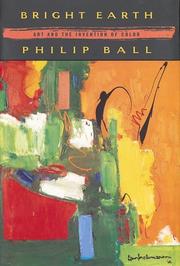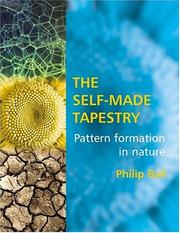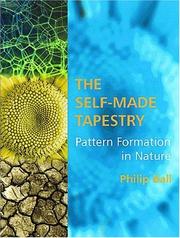| Listing 1 - 10 of 47 | << page >> |
Sort by
|

ISBN: 0374116792 Year: 2002 Publisher: New York (N.Y.) : Farrar, Straus and Giroux,
Abstract | Keywords | Export | Availability | Bookmark
 Loading...
Loading...Choose an application
- Reference Manager
- EndNote
- RefWorks (Direct export to RefWorks)
Art and industry. --- Color in art. --- Coloring matter --- Dyes and dyeing --- History. --- Chemistry.
Book
ISBN: 3642289991 9786613768957 3642290000 1280997346 Year: 2012 Publisher: Heidelberg ; New York : Springer,
Abstract | Keywords | Export | Availability | Bookmark
 Loading...
Loading...Choose an application
- Reference Manager
- EndNote
- RefWorks (Direct export to RefWorks)
Society is complicated. But this book argues that this does not place it beyond the reach of a science that can help to explain and perhaps even to predict social behaviour. As a system made up of many interacting agents – people, groups, institutions and governments, as well as physical and technological structures such as roads and computer networks – society can be regarded as a complex system. In recent years, scientists have made great progress in understanding how such complex systems operate, ranging from animal populations to earthquakes and weather. These systems show behaviours that cannot be predicted or intuited by focusing on the individual components, but which emerge spontaneously as a consequence of their interactions: they are said to be ‘self-organized’. Attempts to direct or manage such emergent properties generally reveal that ‘top-down’ approaches, which try to dictate a particular outcome, are ineffectual, and that what is needed instead is a ‘bottom-up’ approach that aims to guide self-organization towards desirable states. This book shows how some of these ideas from the science of complexity can be applied to the study and management of social phenomena, including traffic flow, economic markets, opinion formation and the growth and structure of cities. Building on these successes, the book argues that the complex-systems view of the social sciences has now matured sufficiently for it to be possible, desirable and perhaps essential to attempt a grander objective: to integrate these efforts into a unified scheme for studying, understanding and ultimately predicting what happens in the world we have made. Such a scheme would require the mobilization and collaboration of many different research communities, and would allow society and its interactions with the physical environment to be explored through realistic models and large-scale data collection and analysis. It should enable us to find new and effective solutions to major global problems such as conflict, disease, financial instability, environmental despoliation and poverty, while avoiding unintended policy consequences. It could give us the foresight to anticipate and ameliorate crises, and to begin tackling some of the most intractable problems of the twenty-first century.
Economics. --- Engineering. --- Physics. --- Social sciences_xData processing. --- Social sciences_xMethodology. --- Physics --- Physical Sciences & Mathematics --- Physics - General --- Interpersonal relations. --- Social psychology. --- Mass psychology --- Psychology, Social --- Human relations --- Interpersonal relationships --- Personal relations --- Relations, Interpersonal --- Relationships, Interpersonal --- Social behavior --- Application software. --- Sociophysics. --- Econophysics. --- Complexity, Computational. --- Social sciences. --- Communication. --- Socio- and Econophysics, Population and Evolutionary Models. --- Methodology of the Social Sciences. --- Complexity. --- Computer Appl. in Social and Behavioral Sciences. --- Economic Systems. --- Communication Studies. --- Human ecology --- Psychology --- Social groups --- Sociology --- Social psychology --- Object relations (Psychoanalysis) --- Social sciences --- Data-driven Science, Modeling and Theory Building. --- Political Economy/Economic Systems. --- Methodology. --- Data processing. --- Economic theory --- Political economy --- Economic man --- Construction --- Industrial arts --- Technology --- Computational complexity. --- Economic policy. --- Mathematical sociology --- Statistical physics --- Communication, Primitive --- Mass communication --- Economic nationalism --- Economic planning --- National planning --- State planning --- Economics --- Planning --- National security --- Social policy --- Application computer programs --- Application computer software --- Applications software --- Apps (Computer software) --- Computer software --- Complexity, Computational --- Electronic data processing --- Machine theory --- Behavioral sciences --- Human sciences --- Sciences, Social --- Social science --- Social studies --- Civilization --- Statistical methods

ISBN: 9780198502432 0198502443 9780198502449 0198502435 Year: 2001 Publisher: Oxford : Oxford university press,
Abstract | Keywords | Export | Availability | Bookmark
 Loading...
Loading...Choose an application
- Reference Manager
- EndNote
- RefWorks (Direct export to RefWorks)
57.017.64 --- 576.36 --- 57.018.722 --- Pattern formation (Biology) --- Biological pattern formation --- 57.018.722 Symmetry --- 576.36 Life cycle of the cell --- Life cycle of the cell --- 57.017.64 Growth. Development. --- Growth. Development. --- Formation des modèles (Biologie) --- Pattern Recognition, Visual --- Biological Phenomena. --- Pattern Recognition, Visual. --- Pattern formation (Biology). --- Symmetry --- Aesthetics --- Proportion --- Developmental biology --- Growth. Development --- Biology. --- Symétrie

ISBN: 0226036286 Year: 2001 Publisher: Chicago : University of Chicago Press,
Abstract | Keywords | Export | Availability | Bookmark
 Loading...
Loading...Choose an application
- Reference Manager
- EndNote
- RefWorks (Direct export to RefWorks)
Philip Ball --- kunst --- schilderkunst --- kunsttheorie --- kleur --- kleurenleer --- oudheid --- renaissance --- barok --- impressionisme --- modernisme --- techniek --- materiaal --- schildertechniek --- verf --- 7.017 --- 75.02 --- 75.03 --- Art and industry --- Color in art --- Coloring matter --- Dyes and dyeing --- Dyestuffs --- Colorings --- Colors in art --- Advertising, Art in --- Industry and art --- History --- Chemistry --- Coal-tar colors --- Pigments --- Art --- Monochrome art --- Industries --- Commercial art

ISBN: 0691027331 Year: 1997 Publisher: Princeton, N.J. Princeton University Press
Abstract | Keywords | Export | Availability | Bookmark
 Loading...
Loading...Choose an application
- Reference Manager
- EndNote
- RefWorks (Direct export to RefWorks)
Materials --- Technological innovations --- Materials sciences --- gegevensopslag --- biologische materialen --- materiaalkennis --- polymeren

ISBN: 0191776297 128075320X 0191518018 1429459840 9780191518010 9780191578250 0191578258 9786610753208 6610753202 9780192840998 0192840991 9780191776298 9781429459846 0192840991 Year: 2004 Publisher: Oxford New York Oxford University Press
Abstract | Keywords | Export | Availability | Bookmark
 Loading...
Loading...Choose an application
- Reference Manager
- EndNote
- RefWorks (Direct export to RefWorks)
This Very Short Introduction traces the history and cultural impact of the elements on humankind, and examines why people have long sought to identify the substances around them. The book covers from the Greek philosophers who propounded a system with four elements - earth, air, fire, and water - to the scientists who are able to create their own.
Chemical elements. --- Elements, Chemical --- Chemical elements

ISBN: 0191585947 0585183481 9780191585944 9780585183480 0198502443 1383020302 Year: 1999 Publisher: Oxford [England] Oxford University Press
Abstract | Keywords | Export | Availability | Bookmark
 Loading...
Loading...Choose an application
- Reference Manager
- EndNote
- RefWorks (Direct export to RefWorks)
This book explains how nature's patterns - the markings on animals, windblown ripples of sand, the forms of water in motion - are woven by self-organization, through simple, local interactions between their component parts.
Pattern formation (Biology) --- Symmetry. --- Symmetry --- Biology --- Health & Biological Sciences --- Biophysics --- Aesthetics --- Proportion --- Biological pattern formation --- Developmental biology --- Geometry in nature.
Book
ISBN: 128238225X 9786612382253 0191528757 9780191528750 9780199237982 0199237980 0191579831 Year: 2009 Publisher: Oxford New York Oxford University Press
Abstract | Keywords | Export | Availability | Bookmark
 Loading...
Loading...Choose an application
- Reference Manager
- EndNote
- RefWorks (Direct export to RefWorks)
Philip Ball explores the science of the branching patterns we see in nature, revealing that there is much more to these networks than meets the eye. Whether trees, snowflakes, forked lightning, or systems of arteries and veins, he explains how there are hidden rules at work that can give us extraordinary insights into the nature of life itself.
Pattern formation (Biology) --- Pattern formation (Physical sciences) --- Chaotic behavior in systems. --- Chaos in systems --- Chaos theory --- Chaotic motion in systems --- Differentiable dynamical systems --- Dynamics --- Nonlinear theories --- System theory --- Chaotic behavior in systems --- Biological pattern formation --- Developmental biology

ISBN: 019161985X 1282199374 0191528730 9780191528736 9780199237968 0199237964 9780191619854 9781282199378 1282346679 9781282346673 9786612346675 6612346671 0191528749 9780191528743 9780199237975 0199237972 9780199237982 Year: 2009 Publisher: Oxford, UK Oxford University Press
Abstract | Keywords | Export | Availability | Bookmark
 Loading...
Loading...Choose an application
- Reference Manager
- EndNote
- RefWorks (Direct export to RefWorks)
Patterns are everywhere in nature--in the ranks of clouds in the sky, the stripes of an angelfish, the arrangement of petals in flowers. Where does this order and regularity come from? As Philip Ball reveals in Nature's Patterns: A Tapestry in Three Parts, this order creates itself. The patterns we see come from self-organization. Indeed, scientists have found that there is a pattern-forming tendency inherent in the basic structure and processes of nature, whether living or non-living, so that from a few simple themes, and the repetition of simple rules, endless beautiful variations can arise.
Pattern formation (Biology) --- Pattern formation (Physical sciences) --- Chaotic behavior in systems. --- Chaos in systems --- Chaos theory --- Chaotic motion in systems --- Differentiable dynamical systems --- Dynamics --- Nonlinear theories --- System theory --- Chaotic behavior in systems --- Biological pattern formation --- Developmental biology --- 57 --- Biological sciences in general --- Formation des structures (Sciences physiques) --- Formation des modèles (Biologie) --- Chaos

ISBN: 1847552609 9781847552600 0854046747 9780854046744 Year: 2005 Publisher: Cambridge : Royal Society of Chemistry,
Abstract | Keywords | Export | Availability | Bookmark
 Loading...
Loading...Choose an application
- Reference Manager
- EndNote
- RefWorks (Direct export to RefWorks)
Devising and performing a scientific experiment is an art, and it is common to hear scientists talk about the 'beauty' of an experiment. What does this mean in chemistry, the experimental science par excellence? And what are the most beautiful chemical experiments of all time? This book offers ten suggestions for where beauty might reside in experimental chemistry. In some cases the beauty lies in the clarity of conception; sometimes it is a feature of the instrumental design. But for chemistry, there can also be a unique beauty in the way atoms are put together to make new molecules, substanc
Chemistry --- Experiments. --- Lecture experiments
| Listing 1 - 10 of 47 | << page >> |
Sort by
|

 Search
Search Feedback
Feedback About UniCat
About UniCat  Help
Help News
News